Review: Invisible, Inc. by Hidden Room Theatre
by Michael Meigs
Co-authored with Dr. David Glen Robinson
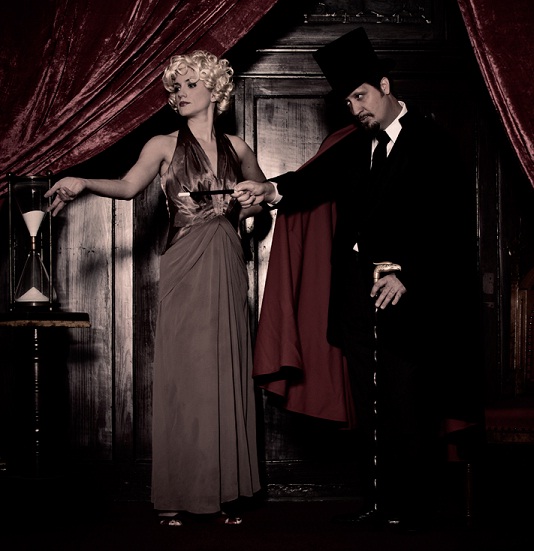
One special appeal is that its leads are Robert Matney and Liz Fisher, a young husband and wife pair who enjoy the sort of respect and affection in Austin that Alfred Lunt and Margot Fontanne had on Broadway from the 1930's through the 1960's. Noël Coward wrote his 1933 Design for Living for that famous couple; coincidentally, Austin Shakespeare will be doing that work in this same venue in just a few weeks. Now, there's a thought experiment: substituting Matney and Fisher for Miller and Merino.
Burns presents a gorgeously designed package. Ia Ensterä's set makes the black box into a Manhattan highrise living room with a broad window at deep center stage, decorated in Art Deco via Bela Lugosi. At the audience's far left stands an upright piano that's part of the same playing space; at the far right there's a tumble of furniture representing a garret somewhere far downtown. With furniture shifts the central playing space can belong to either of these. With a shift in lighting, the flare of a spotlight and a change in the image at deep center stage, the space becomes a theatre complete with proscenium.
P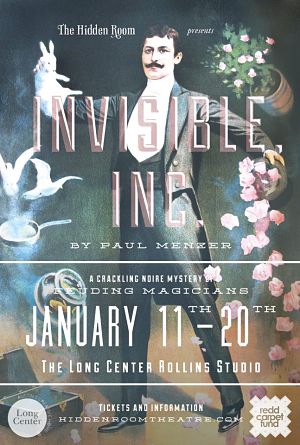 atrons desiring premium seating can pay a bit extra to settle at one of the four-person nightclub tables on the floor with the performing space, where they'll be handsomely welcomed and entertained by an amiable professional magician who does up-close illusions and prestidigitation. On Saturday evening the company's Master of Magic J.D. Stewart was resplendent, gregarious and astonishing. He left us dumbfounded with his skills. We have no idea how those playing cards flew invisibly through the air or those coins appeared impossibly at his bidding.
atrons desiring premium seating can pay a bit extra to settle at one of the four-person nightclub tables on the floor with the performing space, where they'll be handsomely welcomed and entertained by an amiable professional magician who does up-close illusions and prestidigitation. On Saturday evening the company's Master of Magic J.D. Stewart was resplendent, gregarious and astonishing. He left us dumbfounded with his skills. We have no idea how those playing cards flew invisibly through the air or those coins appeared impossibly at his bidding.
Invisible, Inc. is soaked with atmosphere and its spookiness is boosted when the lights first go down and that upright piano erupts into lengthy evocative passes of the keys by the invisible Graham Reynolds. His score for MIDI-assisted player piano punctuates the action with the same dexterity as the big Wurlitzer organs at the cinema palaces of the 1930's.
Menzer’s play offers us the world of vaudeville magic acts and magicians in the 1930’s. The potential for a peek behind the magician’s cabinet is immense, and the playwright gives us several such peeks on our way through the story. The characters present magic turns in every scene, their very gestures accented with flash paper. Handcuffs fall off wrists; cards appear and disappear; straitjackets and cabinets cannot contain them. The disappearance of objects, people and reality raises the tension and the ante, and the onslaught of illusions challenges the audience’s perceptions and certitudes.
The story centers on the fortunes of senior magician Sebastian Topflyte and his band of assistants and fellow magicians doing business as Invisible, Inc. Matney is Topflyte the well-known illusionist, surrounded by his coterie of Question Mark (Sebastian Pears), Doc Isoceles the pyrotechnician (Todd Kassens) and the languorously resentful assistant and frequently disappearing Ladyfingers (Fisher).
The first showy reveal of the performance is that Invisible, Inc. leads a seedy, down-at-heel existence. The band of magicians works nightly in vaudeville, but they aren’t paid much. They’ve mastered all the secrets of magic but they fumble for the secrets of happiness. They make a lot of wine disappear as one result of their disillusion. Having plumbed magic to its source in sleight of hand and deception, Invisible, Inc. seems to have lost all innocence and faith in the magical universe.
Topflyte’s matter-of-fact dominance of the stages in New York City may be under threat, for a new would-be rival Cord McCade (Joseph Garlock) has appeared in the run-down halls of lower Manhattan. Topflyte’s old-fashioned values remain unspoken but firm: the greatest evil is cynicism. His concern is strengthened when he hears that McCade may have been quite literally sawing young women in half. In an alarming development, the older magician learns that his own niece Lucy hasn’t been seen since volunteering at a McCade performance.
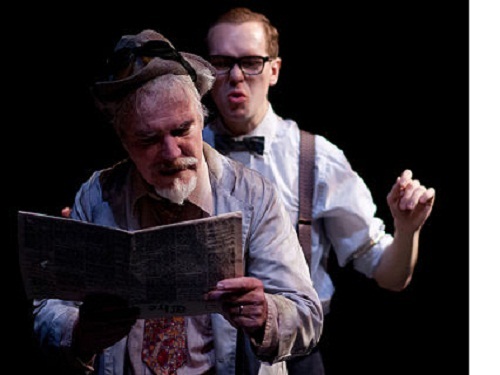
While Topflyte and his henchmen trade quips, the annoyed Ladyfingers sashays off to the nether regions of the City to threaten the newcomer -- thereby spurring successive on-stage confrontations between the master and the upstart. With a loaded pistol, taunting and resentments, these grow increasingly dangerous.
Audience members who love film noir and a good mystery will be captivated. The enigmas are complicated all the more by the intentionally distracting illusions onstage. How on earth did Topflyte make his assistant disappear from that casket suspended at waist height? The guesses of the audience are confounded later when a police inspector accuses Topflyte of murder.
The actors have a lot of work to do onstage. Matney as Topflyte leads the cast adroitly in amusing us, lecturing on the history of magic, advancing the plot and casually performing illusions. His stage work is engaging and holds the play together, as it must. Joseph Garlock is dark, brooding and successful as Cord McCade, the foil to Topflight.

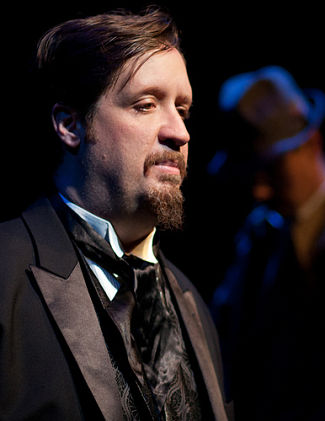
Fisher as Ladyfingers has the most fully realized character. She has her indolent Bronx accent down, and she walks with the hip-throwing slow strut of the 30’s gangster moll; it just has to hurt to walk like that. Both Topflyte and McCade want her. Alone with her, McCade outdoes Topflyte’s casual habitual prestidigitation by appearing to carve her chosen playing card out of his own chest. Ladyfingers’ own heart is the card she is most reluctant to reveal.
Returning UK actor Laurence Pears and Todd Kassens (who played with the 80's Austin band Shoulders) bring much of the humor and a lot of the magic to Invisible, Inc’s cluttered lair. We enjoyed all these characters so much that we’d love to watch them again in Menzer’s next play.

Costumes by Jamie Urban are strictly period and crisply designed. All of them are constructed. One gown in particular, a copy of a Dior worn by Liz Fisher, is thoroughly stunning. Topflyte’s magician suit has the seediness sewed right into it. Clearly, Director Burns and Designer Urban thoroughly get costume as character. Please, let us see more of Urban’s design work.
Justin Cox’s prop and set work is always accurate and innovative, and Ensterä's Art Deco set is a pleasure. A few bobbles are evident in these design fields. The apartment door near the player piano is too wobbly for an exterior door, and this is noticeable from the first entrance at the start of the play.
 The vaudeville entertainments of the 1930s gave way to noir mysteries in literature and film. The Noir genre adopted sharp contrasts in lighting as a kind of lighting signature, borrowing from chiaroscuro in Renaissance and Baroque art. The style was also conducive to use in black-and-white movies, in which focal action played in bright light set off by inky pools of blackness in the background.
The vaudeville entertainments of the 1930s gave way to noir mysteries in literature and film. The Noir genre adopted sharp contrasts in lighting as a kind of lighting signature, borrowing from chiaroscuro in Renaissance and Baroque art. The style was also conducive to use in black-and-white movies, in which focal action played in bright light set off by inky pools of blackness in the background.
Choice is everything, and designer Megan Reilly eschews this esthetic, preferring more muted lighting sets throughout the play, accented by following spots in the theatre scenes, work that’s ably carried out by the multi-talented Cami Alys. Still, Dr. Dave would have preferred greater contrasts between some of the lighting sets, particularly a heightening of difference between Invisible, Inc.’s seedy lair and McCade’s even seedier garret off lower Broadway.
Concerning Illusion -- and Possible Spoilers
As with all accomplished magic acts, Menzer's story relies on the techniques of patter, distraction and misdirection. He successfully pulls off one stunt concerning a major character, turning the accepted theatrical convention of character doubling to his advantage. Some may be surprised at the plot turn; others will congratulate themselves for having seen through the trick.
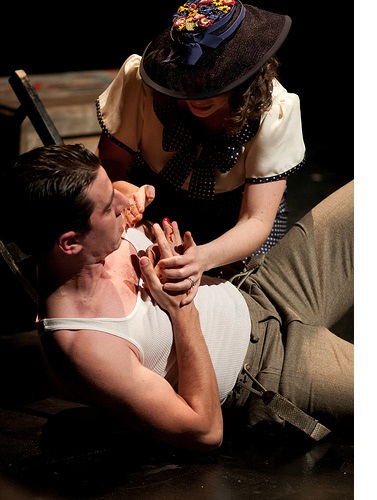 Two major flaws remain. The first is his failure to fulfill our desire to see the mystery of the missing Lucy adequately resolved. The audience spends more than an hour awaiting that finis, only to see a fashionably clad young woman throw herself upon McCade at a moment of climax. We hear nothing further from her. Topflyte may have provided a one-sentence summary in the following scene, but if so it passed in such a confusion of events that the uninitiated -- that is, virtually everyone seated in the audience -- probably missed it.
Two major flaws remain. The first is his failure to fulfill our desire to see the mystery of the missing Lucy adequately resolved. The audience spends more than an hour awaiting that finis, only to see a fashionably clad young woman throw herself upon McCade at a moment of climax. We hear nothing further from her. Topflyte may have provided a one-sentence summary in the following scene, but if so it passed in such a confusion of events that the uninitiated -- that is, virtually everyone seated in the audience -- probably missed it.
The second is the use of anachronism in the finale, limited pretty much to the casual dress of the investigating female detective and to Topflyte's comment that he was stepping out to fetch some carry-out sushi. Sushi? Or even more intriguingly, carry-out? In a 1930's New York of restaurants and the automats of Horn & Hardart?
We'd have no objection to a last-minute gotcha for Invisible, Inc. proving that we'd been successfully misled about the when, where and how of the story -- but as written and delivered, that final attempted trick was inexplicable and, in fact, largely imperceptible. Both of us missed it. We assumed momentary lapses on the part of costumer Urban and the playwright. Perhaps even more intriguing is the fact that during the Saturday evening talk-back neither Menzer nor anyone in the company mentioned the deliberate anachronisms.
Every magician counts on the persistence of perception to astonish and amaze. The illusionist encourages our expectations, sets the scene and sends us happily along, expecting one result and dazzling us with something entirely different. Not here: the frame-breaking at the end did not work at all, and it amounted to playing a trick on the audience rather than playing tricks with or for them. Following a highly entertaining tale with vivid characters, Invisible, Inc. seemed to drop the top hat and not to bother to find the rabbit that was supposed to be inside it.
Review by Jeff Davis for www.austin.broadwayworld.com, January 11
Review by Dan Solomon for the Austin Chronicle, January 17
Review by Ryan E. Johnson for www.austinlifestylemag.com, January 18
EXTRAS
Two-minute feature at KUT's 'Arts Eclectic'; Mike Lee interviews the leads, January 15
Click to view the program for Invisible, Inc. by the Hidden Room Theatre
Hits as of 2015 03 01: 4069
Invisible, Inc.
by Paul Menzer
Hidden Room Theatre
